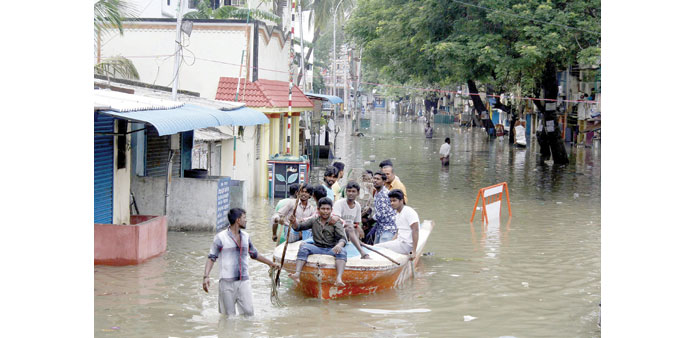Men with a boat move people to safety on a flooded street after heavy rains in Chennai on November 18. Large areas of the southern Indian city of Chennai have been flooded following days of heavy rain. Photo by AFP
By Steff Gaulter
Torrential rain has been pouring incessantly across southeast India and Sri Lanka. Puddles have grown into giant lakes and parts of the region have ground to a halt.
In India, it is the state of Tamil Nadu that has been worst hit. Dozens of people have been killed by the rising water, although very few, if any, have actually died from drowning. In India, the majority of those who lose their lives in flooding are either crushed to death by walls that collapse in the rain, or they are electrocuted. Power lines in the region are often poorly insulated, meaning that submerging them in water will turn the water deadly. Anyone unfortunate enough to be in the water will immediately be killed.
In the slums, the situation is even worse. The amateur construction of the electrical lines is far from safe and even a small shower often causes a power cut. On top of this, very little force is required to topple one of the rustic homes, sometimes a heavy downpour is all it takes.
Over the last week, the torrential rain caused the flood water to steadily rise. Schools closed, roads became impassable and rail tracks disappeared under water. As the trains were brought to a standstill, thousands of people were stranded. Determined businessmen were seen wading to their offices knee-deep in filthy floodwater.
Given that it’s currently November, the recent flooding may surprise you. Most people know that the region receives a vast amount of rain during the summer monsoon. These rains have long since retreated, but the summer monsoon isn’t the only time that parts of India and Sri Lanka see torrential rain.
Between October and January, the winter monsoon blows across the area. This monsoon isn’t as well known as the summer monsoon, but in many ways it is no less important. For much of the country the winter monsoon brings clear, cool conditions, but not everywhere. In some locations the winter monsoon brings even more rain than the summer monsoon.
The monsoons over India are triggered by the sheer size of Asia’s landmass, and the fact that the sun can heat land quicker than the sea. In summer, as the land bakes, the air over the land also heats up. As you may remember from your Physics lessons at school, hot air rises, so the hot air over the land rises and air from the sea rushes in to take its place. This is the same theory as a sea breeze that develops on a hot day, helpfully cooling down the sunbathers.
This influx of air is the summer monsoon. As it has been sitting over the sea for months, it is laden with moisture. It moves northeast over land, delivering torrential rain to Sri Lanka and India, before tracking northwards across Pakistan. It flows from the southwest, so the heaviest rain is on the west of India, with the eastern parts being slightly more sheltered.
In the winter, the opposite happens. The land loses heat quicker than the sea, so the air over the sea is warmer than that over the land. This forces the air to flow southeast, streaming down from the Himalayas and across India. As the winds originate over land, they are dry and bring very little in the way of rain. However, due to the shape of India, these winds do cross the Bay of Bengal before flowing over southeast India and Sri Lanka. As they flow over the sea, they manage to pick up some moisture, which they deliver as rain, mostly along the coast.
With rain promised in both the summer and the winter monsoons, the coast of southeast India is therefore a rather wet place. This includes Chennai, the capital of Tamil Nadu. The wettest month in the soggy city is November, but even for Chennai, the rain this month has been exceptional.
In just four days, between November 8 and November 11, the city received 221 millimetres (8.7 inches) of rain. Then the heavens opened and 233 millimetres (9.1 inches) of rain inundated the city in just 24 hours. Chennai normally expects 353 millimetres (13.9 inches) of rain in the entire month of November, so clearly this amount of rain was exceptional, even for the soggy city.
The deluge was caused by an area of low pressure which formed to the east of the country. This weather feature threatened to become a tropical cyclone for over a week, but it never quite managed to gather strength. However, just because it didn’t have the title, didn’t mean it wasn’t capable of causing widespread disruption.
The low pressure directed heavy showers towards southeast India and Sri Lanka. It was the persistence of these showers that caused the flooding, as much as their intensities. Sadly, if the low pressure had become a tropical cyclone, it would probably have moved. This would have spared the region the prolonged onslaught and reduced the flooding.



